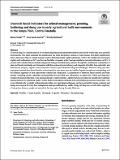Por favor, use este identificador para citar o enlazar a este item:
http://hdl.handle.net/10261/198349COMPARTIR / EXPORTAR:
 SHARE SHARE
 CORE
BASE CORE
BASE
|
|
| Visualizar otros formatos: MARC | Dublin Core | RDF | ORE | MODS | METS | DIDL | DATACITE | |

| Título: | Livestock faecal indicators for animal management, penning, foddering and dung use in early agricultural built environments in the Konya Plain, Central Anatolia |
Autor: | Portillo, Marta CSIC ORCID ; García-Suárez, Aroa; Matthews, Wendy | Palabras clave: | Neolithic Central Anatolia Husbandry Coprolite Biomarkers Geoarchaeology |
Fecha de publicación: | 2020 | Editor: | Springer Nature | Citación: | Archaeological and Anthropological Sciences : https://doi.org/10.1007/s12520-019-00988-0 (2020) | Resumen: | Livestock dung is a valuable material for reconstructing human and animal inter-relations and activity within open areas and built environments. This paper examines the identification and multi-disciplinary analysis of dung remains from three neighbouring sites in the Konya Plain of Central Anatolia, Turkey: Boncuklu (ninth–eighth millennium cal BC), the Çatalhöyük East Mound (eighth–sixth millennium cal BC), and the Late Neolithic occupation at the Pınarbaşı rockshelter (seventh millennium cal BC). It presents and evaluates data on animal management strategies and husbandry practices through the simultaneous examination of plant and faecal microfossils and biomarkers with thin-section micromorphology and integrated phytolith, dung spherulite, and biomolecular analyses, together with comparative reference geo-ethnoarchaeological assemblages. Herbivore dung and other coprogenic materials have been identified predominantly in open areas, pens and midden deposits through micromorphology and the chemical signatures of their depositional contexts and composition. Accumulations of herbivore faecal material and burnt remains containing calcitic spherulites and phytoliths have provided new information on animal diet, fodder and dung fuel. Evidence from phytoliths from in situ penning deposits at early Neolithic Çatalhöyük have provided new insights into foddering/grazing practices by identifying highly variable herbivorous regimes including both dicotyledonous and grass-based diets. This review illustrates the variability of dung depositswithin early agricultural settlements and their potential for tracing continuity and change in ecological diversity, herd management strategies and foddering, health, energy and dung use, as well as the complexity of interactions between people and animals in this key region during the early Holocene. | Versión del editor: | https://doi.org/10.1007/s12520-019-00988-0 https://link.springer.com/article/10.1007/s12520-019-00988-0 |
URI: | http://hdl.handle.net/10261/198349 | DOI: | 10.1007/s12520-019-00988-0 | ISSN: | 1866-9557 | E-ISSN: | 1866-9565 |
| Aparece en las colecciones: | (IMF) Artículos |
Ficheros en este ítem:
| Fichero | Descripción | Tamaño | Formato | |
|---|---|---|---|---|
| Portillo-2020-Livestock faecal indicators for animal management.pdf | 4,16 MB | Adobe PDF |  Visualizar/Abrir |
CORE Recommender
PubMed Central
Citations
3
checked on 16-abr-2024
SCOPUSTM
Citations
31
checked on 12-abr-2024
WEB OF SCIENCETM
Citations
30
checked on 25-feb-2024
Page view(s)
224
checked on 17-abr-2024
Download(s)
197
checked on 17-abr-2024

